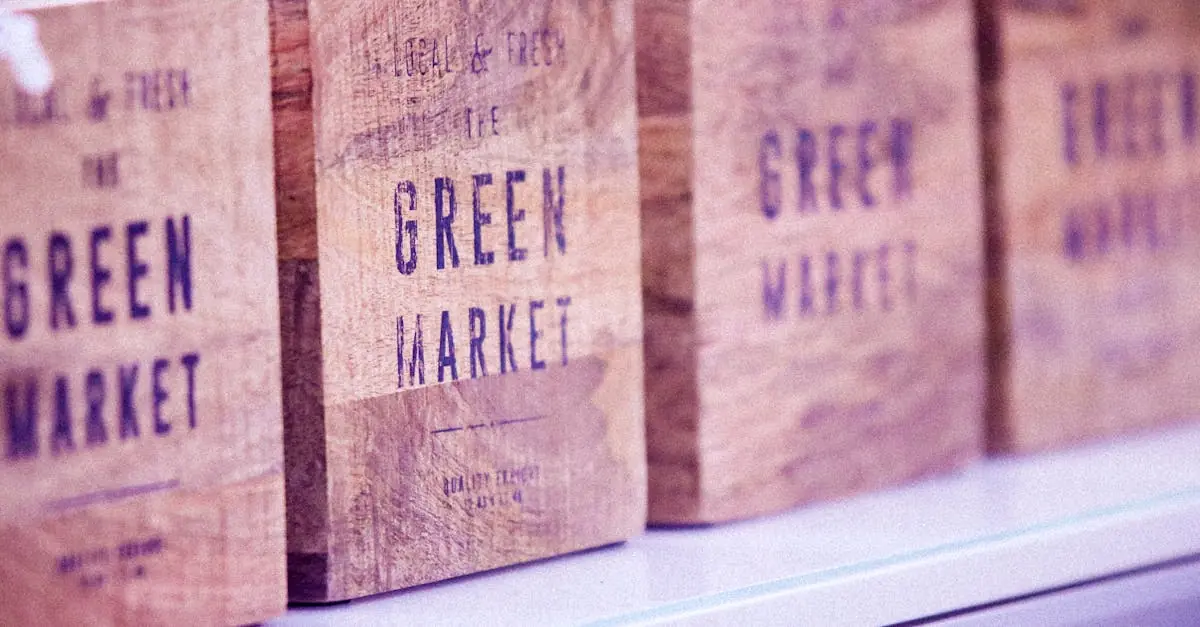Table of Contents
ToggleIn a world dominated by fast fashion and mass production, vintage goods have become the quirky heroes of the retail realm. They’re not just old; they’re timeless treasures waiting to be discovered. From retro clothing to classic furniture, selling vintage items isn’t just a trend—it’s a chance to turn nostalgia into cash. Who wouldn’t want to make a profit while giving a second life to something that’s seen more history than most of us?
Understanding Vintage Goods
Vintage goods refer to items that possess historical significance or aged craftsmanship. Such items appeal to a wide audience, enriching lives with their stories and unique designs.
What Qualifies as Vintage?
Vintage items typically require a minimum age of 20 years, distinguishing them from antiques, which are at least 100 years old. Periods like the 1920s through the 1990s produce popular vintage pieces. Condition matters, as well-preserved items attract collectors and enthusiasts. Specific brand names or designers often enhance an item’s vintage status due to their renowned histories. Provenance can also play a crucial role, where an item’s history adds value and authenticity.
Popular Vintage Items to Sell
Popular categories of vintage items include clothing, accessories, and furniture. Vintage clothing often consists of unique pieces from past decades, appealing to fashion-conscious buyers. Accessories, such as jewelry and handbags, captivate collectors seeking one-of-a-kind gems. Furniture from mid-century modern designs commands high interest due to its iconic aesthetics. Vinyl records also maintain popularity, as they provide nostalgia and rich sound quality. These items not only reflect timeless style but also resonate with various buyer demographics, ensuring continued demand.
Where to Sell Vintage Goods
Selling vintage goods occurs in various environments, from online platforms to local markets. Each venue offers unique opportunities and challenges.
Online Platforms
Online platforms serve as extensive marketplaces for vintage goods. Websites such as Etsy and eBay allow sellers to reach a global audience. Sellers benefit from these sites by showcasing unique vintage clothing, accessories, and collectibles. Social media channels, including Instagram and Facebook Marketplace, provide additional avenues for connecting with buyers. Sellers can share enticing photos and stories that enhance the value of their items. Successful online sales often result from properly researching prices and understanding market demand.
Local Markets and Fairs
Local markets and fairs present excellent opportunities for selling vintage goods. Flea markets and craft fairs attract enthusiastic shoppers looking for one-of-a-kind items. Vendors often engage directly with customers, allowing for personal interactions that can boost sales. Participants can also set up booths to display a variety of vintage items, from furniture to vinyl records. Networking with other vendors provides insights into pricing and popular trends. By participating in these events, sellers can enhance their visibility within the vintage community.
Pricing Your Vintage Goods
Setting the right price for vintage goods plays a crucial role in attracting buyers while ensuring profitability. Sellers must consider various factors that influence vintage pricing, such as rarity and condition.
Factors to Consider
Condition significantly affects value. Items in excellent condition fetch higher prices. Rarity also matters; the fewer available items, the more valuable they become. Brand reputation adds another layer of worth. Pieces from renowned brands often demand premium pricing. Market trends impact pricing as well; staying updated on current demands helps in adjusting prices appropriately.
How to Determine Value
Researching similar items online provides insight into current market values. Checking recent sales on platforms like Etsy or eBay can help gauge price ranges. Analyzing completed listings offers a clear view of what buyers are willing to pay. Consulting pricing guides specific to vintage items aids in establishing baseline values. Lastly, enlisting the expertise of appraisers or local vintage shops helps validate pricing decisions.
Marketing Your Vintage Goods
Marketing vintage goods effectively enhances visibility and sales. Employing targeted strategies ensures sellers connect with the right audience and showcase their unique offerings.
Effective Strategies
Utilizing social media is crucial in promoting vintage items. Instagram enables sellers to create visually appealing posts that highlight item details. Engaging storytelling attracts potential buyers, creating intrigue. Email marketing maintains consistent communication with past customers, reminding them of new arrivals. Search engine optimization improves online visibility, driving traffic to listings. Collaborating with influencers amplifies reach, exposing vintage goods to broader audiences. Experimenting with different platforms ensures sellers discover what works best for their particular niche.
Building a Brand Presence
Establishing a cohesive brand identity is vital for vintage sellers. Developing a unique logo strengthens recognition among buyers. Consistent branding across multiple platforms fosters trust and loyalty. Crafting a compelling narrative about the vintage goods and their history creates emotional connections. Participating in community events enhances local presence while connecting with potential customers. Engaging with followers through comments and messages builds relationships, encouraging repeat sales. Utilizing a professional website can further enhance credibility, providing a central hub for collectors to explore offerings.
Selling vintage goods offers a unique blend of passion and profit. As the demand for these timeless items continues to grow sellers can tap into a market that values history and craftsmanship. By leveraging online platforms and local markets sellers can effectively reach diverse audiences while showcasing the stories behind their products.
Pricing vintage items thoughtfully and marketing them creatively are essential steps toward success. Engaging with customers through social media and personal interactions can create lasting relationships that encourage repeat business. With the right approach vintage selling not only revitalizes cherished items but also fosters a vibrant community of enthusiasts who appreciate the beauty of the past.








